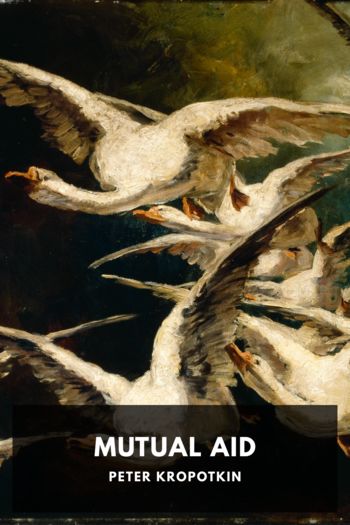Mutual Aid, Peter Kropotkin [fiction novels to read .txt] 📗

- Author: Peter Kropotkin
Book online «Mutual Aid, Peter Kropotkin [fiction novels to read .txt] 📗». Author Peter Kropotkin
The feeling of union within the confederation is kept alive by the common interests of the tribes, their folkmotes, and the festivities which are usually kept in connection with the folkmotes. The same feeling is, however, maintained by another institution, the aba, or common hunt, which is a reminiscence of a very remote past. Every autumn, the forty-six clans of Kudinsk come together for such a hunt, the produce of which is divided among all the families. Moreover, national abas, to assert the unity of the whole Buryat nation, are convoked from time to time. In such cases, all Buryat clans which are scattered for hundreds of miles west and east of Lake Baikal, are bound to send their delegate hunters. Thousands of men come together, each one bringing provisions for a whole month. Everyone’s share must be equal to all the others, and therefore, before being put together, they are weighed by an elected elder (always “with the hand”: scales would be a profanation of the old custom). After that the hunters divide into bands of twenty, and the parties go hunting according to a well-settled plan. In such abas the entire Buryat nation revives its epic traditions of a time when it was united in a powerful league. Let me add that such communal hunts are quite usual with the Red Indians and the Chinese on the banks of the Usuri (the kada).145
With the Kabyles, whose manners of life have been so well described by two French explorers,146 we have barbarians still more advanced in agriculture. Their fields, irrigated and manured, are well attended to, and in the hilly tracts every available plot of land is cultivated by the spade. The Kabyles have known many vicissitudes in their history; they have followed for sometime the Mussulman law of inheritance, but, being adverse to it, they have returned, 150 years ago, to the tribal customary law of old. Accordingly, their land-tenure is of a mixed character, and private property in land exists side by side with communal possession. Still, the basis of their present organization is the village community, the thaddart, which usually consists of several joint families (kharoubas), claiming a community of origin, as well as of smaller families of strangers. Several villages are grouped into clans or tribes (ârch); several tribes make the confederation (thak’ebilt); and several confederations may occasionally enter into a league, chiefly for purposes of armed defence.
The Kabyles know no authority whatever besides that of the djemmâa, or folkmote of the village community. All men of age take part in it, in the open air, or in a special building provided with stone seats. And the decisions of the djemmâa are evidently taken at unanimity: that is, the discussions continue until all present agree to accept, or to submit to, some decision. There being no authority in a village community to impose a decision, this system has been practised by mankind wherever there have been village communities, and it is practised still wherever they continue to exist, i.e. by several hundred million men all over the world. The djemmâa nominates its executive—the elder, the scribe, and the treasurer; it assesses its own taxes; and it manages the repartition of the common lands, as well as all kinds of works of public utility. A great deal of work is done in common: the roads, the mosques, the fountains, the irrigation canals, the towers erected for protection from robbers, the fences, and so on, are built by the village community; while the highroads, the larger mosques, and the great marketplaces are the work of the tribe. Many traces of common culture continue to exist, and the houses continue to be built by, or with the aid of, all men and women of the village. Altogether, the “aids” are of daily occurrence, and are continually called in for the cultivation of the fields, for harvesting, and so on. As to the skilled work, each community has its blacksmith, who enjoys his part of the communal land, and works for the community; when the tilling season approaches he visits every house, and repairs the tools and the ploughs, without expecting any pay, while the making of new ploughs is considered as a pious work which can by no means be recompensed in money, or by any other form of salary.
As the Kabyles already have private property, they evidently have both rich and poor among them. But like all people who closely live together, and know how poverty begins, they consider it as an accident which may visit everyone. “Don’t say that you will never wear the beggar’s bag, nor go to prison,” is a proverb of the Russian peasants; the Kabyles practise it, and no difference can be detected in the external behaviour between rich and poor; when the poor convokes an “aid,” the rich man works in his field, just as the poor man does it reciprocally in his turn.147 Moreover, the djemmâas set aside certain gardens and fields, sometimes cultivated in common, for the use of the poorest members. Many like customs continue to exist. As the poorer families would not be able to buy meat, meat is regularly bought with the money of the fines, or





Comments (0)